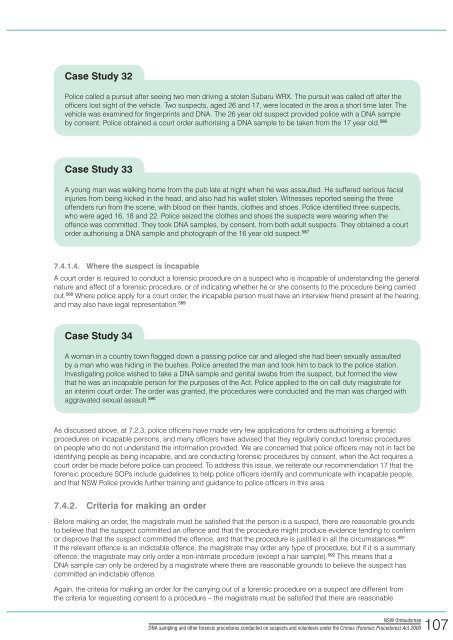Crimes (Forensic Procedures) Act 2000 - NSW Ombudsman - NSW ...
Crimes (Forensic Procedures) Act 2000 - NSW Ombudsman - NSW ...
Crimes (Forensic Procedures) Act 2000 - NSW Ombudsman - NSW ...
You also want an ePaper? Increase the reach of your titles
YUMPU automatically turns print PDFs into web optimized ePapers that Google loves.
Case Study 32<br />
Police called a pursuit after seeing two men driving a stolen Subaru WRX. The pursuit was called off after the<br />
officers lost sight of the vehicle. Two suspects, aged 26 and 17, were located in the area a short time later. The<br />
vehicle was examined for fingerprints and DNA. The 26 year old suspect provided police with a DNA sample<br />
by consent. Police obtained a court order authorising a DNA sample to be taken from the 17 year old. 586<br />
Case Study 33<br />
A young man was walking home from the pub late at night when he was assaulted. He suffered serious facial<br />
injuries from being kicked in the head, and also had his wallet stolen. Witnesses reported seeing the three<br />
offenders run from the scene, with blood on their hands, clothes and shoes. Police identified three suspects,<br />
who were aged 16, 18 and 22. Police seized the clothes and shoes the suspects were wearing when the<br />
offence was committed. They took DNA samples, by consent, from both adult suspects. They obtained a court<br />
order authorising a DNA sample and photograph of the 16 year old suspect. 587<br />
7.4.1.4. Where the suspect is incapable<br />
A court order is required to conduct a forensic procedure on a suspect who is incapable of understanding the general<br />
nature and effect of a forensic procedure, or of indicating whether he or she consents to the procedure being carried<br />
out. 588 Where police apply for a court order, the incapable person must have an interview friend present at the hearing,<br />
and may also have legal representation. 589<br />
Case Study 34<br />
A woman in a country town flagged down a passing police car and alleged she had been sexually assaulted<br />
by a man who was hiding in the bushes. Police arrested the man and took him to back to the police station.<br />
Investigating police wished to take a DNA sample and genital swabs from the suspect, but formed the view<br />
that he was an incapable person for the purposes of the <strong>Act</strong>. Police applied to the on call duty magistrate for<br />
an interim court order. The order was granted, the procedures were conducted and the man was charged with<br />
aggravated sexual assault. 590<br />
As discussed above, at 7.2.3, police officers have made very few applications for orders authorising a forensic<br />
procedures on incapable persons, and many officers have advised that they regularly conduct forensic procedures<br />
on people who do not understand the information provided. We are concerned that police officers may not in fact be<br />
identifying people as being incapable, and are conducting forensic procedures by consent, when the <strong>Act</strong> requires a<br />
court order be made before police can proceed. To address this issue, we reiterate our recommendation 17 that the<br />
forensic procedure SOPs include guidelines to help police officers identify and communicate with incapable people,<br />
and that <strong>NSW</strong> Police provide further training and guidance to police officers in this area.<br />
7.4.2. Criteria for making an order<br />
Before making an order, the magistrate must be satisfied that the person is a suspect, there are reasonable grounds<br />
to believe that the suspect committed an offence and that the procedure might produce evidence tending to confirm<br />
or disprove that the suspect committed the offence, and that the procedure is justified in all the circumstances. 591<br />
If the relevant offence is an indictable offence, the magistrate may order any type of procedure, but if it is a summary<br />
offence, the magistrate may only order a non-intimate procedure (except a hair sample). 592 This means that a<br />
DNA sample can only be ordered by a magistrate where there are reasonable grounds to believe the suspect has<br />
committed an indictable offence.<br />
Again, the criteria for making an order for the carrying out of a forensic procedure on a suspect are different from<br />
the criteria for requesting consent to a procedure – the magistrate must be satisfied that there are reasonable<br />
<strong>NSW</strong> <strong>Ombudsman</strong><br />
DNA sampling and other forensic procedures conducted on suspects and volunteers under the <strong>Crimes</strong> (<strong>Forensic</strong> <strong>Procedures</strong>) <strong>Act</strong> <strong>2000</strong> 107

















